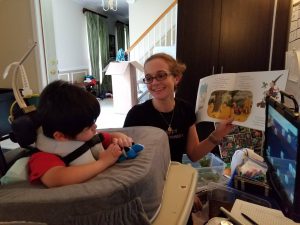 Halloween is long over, so you can file this post away from next year. My own children love the book, Room on the Broom, but when I read it with my “Is this for Joey?” eyes I realized just what a great book it is.
Halloween is long over, so you can file this post away from next year. My own children love the book, Room on the Broom, but when I read it with my “Is this for Joey?” eyes I realized just what a great book it is.
Room on the Broom, written by Julia Donaldson and Alex Scheffler, is the story of a witch who is riding around on her broomstick. As the wind picks up, her hat, bow, and wand are blown away. Each time she goes to look for an item she meets a new friend (a dog, a bird, and a frog), each who asks her if there is room on the broom for one more friend. Eventually the broom becomes so full that it breaks, and the witch falls next to a dragon who wants to eat her. Before he can, the friends she made room for band together to save her. On the surface level it’s a great story about inclusion and friendship. But let’s look beyond that.
Prepositions: Room on the Broom is perfect for working on prepositions, because the witch’s movements are repeated. Each time the witch flies over the field, says “down” or “up”, I can include Joey’s AAC device. At first I modeled these words on the AAC device as I read, but after awhile I was able to pause and wait for Joey to fill in the down, up, or over word. These actions are also easy to act out, so you can fly a broom or a witch up and down to create a real life model of the preposition.
Weather: While it is easy to find books specifically about weather, we don’t always find opportunities to talk about weather in regular (fun and engaging) read alouds. When I’ve read this book to my own children, the weather seemed like a back story we barely commented on. Yet Joey started pointing out the weather changes to me the first time we read the story. Of course! How did I not see it before? The witch’s difficulties are all because of the coming storm. Joey has weather words on his device, and it is rare that we can use these words outside of the calendar routine. Not only can we label the weather here, but Joey can explain why the witch’s hat fell off – the wind blew it down. Suddenly, these static weather words have become a part of the plot line, and he can meaningfully use them to discuss the story.
Early Math Routines: This book is also excellent for supporting one to one correspondence when counting. There are five main characters (the witch, cat, dog, frog, and bird). Five is a great base number to count and use for number stories. On a simple level, we can count one through five. We can practice the “add one more” concept by starting to count the witch and the count, and then add on each additional animal. “Now we have three!” “Now we have four!”
The math concept I like the most here is that we can practice matching one to one. Five friends each need five seats, and each needs to put one item into the witch’s cauldron. Matching up the five friends, five items, and five seats reinforces to children that counting represents a set number of objects. Initially, some children are able to count but unable to match the memorized count “1, 2, 3” to three items. This book gives an easy, meaningful opportunity to match set amounts with other set amounts. This also helps reinforce the concept of equal and same. So much math!


